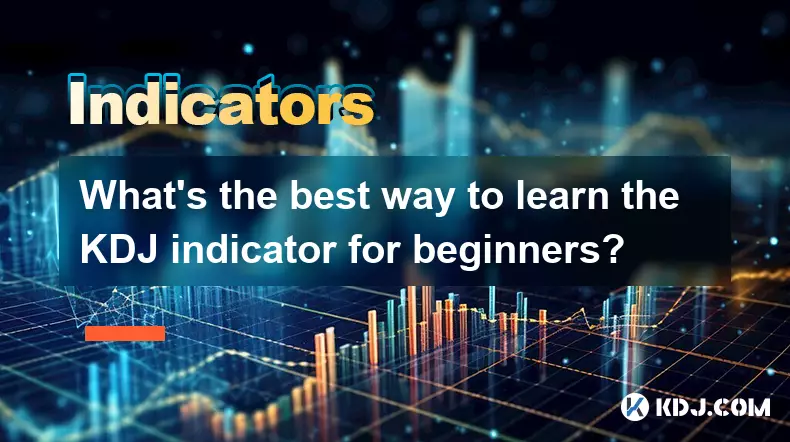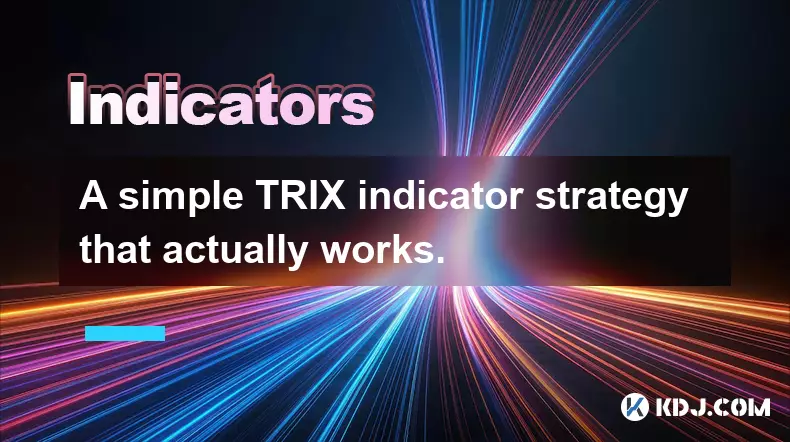-
 bitcoin
bitcoin $101752.865364 USD
-1.09% -
 ethereum
ethereum $3382.985899 USD
-1.38% -
 tether
tether $0.999658 USD
0.04% -
 xrp
xrp $2.272505 USD
-1.51% -
 bnb
bnb $989.089004 USD
0.14% -
 solana
solana $156.962612 USD
-3.08% -
 usd-coin
usd-coin $0.999776 USD
0.01% -
 tron
tron $0.290786 USD
-0.69% -
 dogecoin
dogecoin $0.174594 USD
-2.86% -
 cardano
cardano $0.560085 USD
-3.55% -
 hyperliquid
hyperliquid $40.023704 USD
-5.75% -
 chainlink
chainlink $15.324649 USD
-2.78% -
 bitcoin-cash
bitcoin-cash $493.576540 USD
-3.52% -
 zcash
zcash $571.320038 USD
-12.05% -
 stellar
stellar $0.280066 USD
-4.26%
What's the best way to learn the KDJ indicator for beginners?
The KDJ indicator enhances stochastic analysis with its J line, helping traders spot reversals and overbought/oversold levels in volatile crypto markets.
Nov 07, 2025 at 09:40 am

Understanding the Basics of the KDJ Indicator
1. The KDJ indicator is a momentum oscillator widely used in cryptocurrency trading to identify overbought and oversold conditions. It expands on the stochastic oscillator by adding a third line known as the J line, which helps traders spot turning points more effectively. Beginners should start by learning how each component—K, D, and J—is calculated and what they represent in market dynamics.
2. The K value reflects the current closing price relative to the high-low range over a set period, typically 9 days. This raw momentum reading is then smoothed into the D line, which acts as a signal line. The J line, derived from 3 times the K value minus 2 times the D value, often moves more drastically and can indicate early trend reversals or extreme sentiment shifts within the crypto market.
3. A solid foundation includes recognizing standard threshold levels: readings above 80 suggest overbought conditions, while values below 20 point to oversold zones. These thresholds are especially relevant in volatile markets like Bitcoin or Ethereum, where rapid price swings can trigger false signals if not interpreted with additional context.
4. Visualizing the KDJ on charting platforms such as TradingView or MetaTrader allows beginners to observe real-time interactions between price action and indicator movement. By applying the KDJ to historical data across different timeframes—such as 1-hour, 4-hour, or daily charts—learners gain insight into how the indicator behaves during bull runs, corrections, and consolidation phases common in the crypto space.
Practical Steps to Master KDJ Application
1. Set up a demo account on a cryptocurrency exchange that supports advanced charting tools. Practice applying the KDJ indicator across various digital assets including major coins like BTC, ETH, and altcoins such as SOL or ADA. This hands-on experience builds familiarity without financial risk.
2. Focus on identifying crossovers between the K and D lines. When the K line crosses above the D line in the oversold region, it may signal a potential upward move. Conversely, a K line crossing below the D line in overbought territory could suggest downward pressure. These patterns become more reliable when aligned with volume spikes or key support/resistance levels.
3. Always combine KDJ readings with other technical tools such as moving averages, RSI, or MACD to reduce false signals. For example, a bullish KDJ crossover occurring near a long-term exponential moving average (EMA) adds credibility to a potential reversal, particularly after extended downtrends seen during bear markets.
4. Keep a trading journal documenting every KDJ-based decision, including entry, exit, and the surrounding market conditions. Review these entries weekly to assess accuracy and refine interpretation skills. Over time, this process sharpens pattern recognition and improves judgment under real market volatility.
Common Pitfalls and How to Avoid Them
1. One frequent mistake is acting on KDJ signals without considering broader market context. In strong trending environments, the indicator can remain overbought or oversold for prolonged periods, leading to premature trades. Waiting for confirmation through candlestick patterns or breakout retests minimizes such errors.
2. Adjusting the default settings blindly can distort signal reliability. While some traders modify the lookback period or smoothing factors, beginners should stick to standard configurations until they fully grasp the baseline behavior. Deviations should only follow thorough backtesting on historical data.
3. Ignoring divergence between price and the KDJ line is another critical oversight. If prices make new highs but the KDJ fails to surpass its previous peak, this bearish divergence might foreshadow a correction. Similarly, bullish divergence occurs when prices hit lower lows while the KDJ forms higher lows, hinting at strengthening buying pressure beneath the surface.
4. Emotional trading amplifies misinterpretation. Seeing a sudden J line spike into overbought territory might tempt impulsive selling, yet in fast-moving crypto rallies, such extremes often persist. Discipline and adherence to predefined rules prevent reactive decisions driven by fear or greed.
Frequently Asked Questions
What does the J line tell us that K and D don’t? The J line provides an amplified view of momentum by combining the K and D values with a multiplier. Its wider swings help detect rapid changes in market sentiment before they fully reflect in the K and D lines, making it useful for spotting early reversal zones in highly volatile cryptocurrencies.
Can the KDJ indicator be used effectively on short timeframes like 5-minute charts? Yes, though with caution. On shorter timeframes, the KDJ generates more frequent signals due to increased price noise. Traders using scalping strategies may benefit from tighter parameters, but must incorporate filters like volume analysis or horizontal support/resistance to improve accuracy.
Is the KDJ suitable for all types of cryptocurrencies? It works best on assets with sufficient liquidity and consistent trading volume. Low-cap altcoins with erratic price movements may produce unreliable KDJ signals due to manipulation or thin order books. Stick to well-established coins when starting out.
Disclaimer:info@kdj.com
The information provided is not trading advice. kdj.com does not assume any responsibility for any investments made based on the information provided in this article. Cryptocurrencies are highly volatile and it is highly recommended that you invest with caution after thorough research!
If you believe that the content used on this website infringes your copyright, please contact us immediately (info@kdj.com) and we will delete it promptly.
- Ripple (XRP) in 2026: Hold or Fold? A Look at XRP's Future and Emerging DeFi Alternatives
- 2025-11-08 18:35:01
- Zcash ZEC Coin Price Explosion: From Privacy Niche to Center Stage
- 2025-11-08 18:55:01
- Berachain Price Prediction: Navigating the Honeycomb Hype in Crypto
- 2025-11-08 18:55:01
- Arthur Hayes, Gold, and Bitcoin: A Modern Monetary Trinity?
- 2025-11-08 19:15:01
- Shiba Inu's Next Move: Navigating a Shifting Market
- 2025-11-08 19:20:01
- Pakistan's Crypto Crossroads: Balancing Opportunity with Asset-Backed Realities
- 2025-11-08 19:20:01
Related knowledge

How do professional traders use the TRIX indicator?
Nov 06,2025 at 04:40pm
Understanding the TRIX Indicator in Crypto TradingThe TRIX (Triple Exponential Average) indicator is a momentum oscillator used by professional trader...

Can I use the TRIX indicator on my mobile trading app?
Nov 07,2025 at 07:40pm
The TRIX indicator, a momentum oscillator designed to filter out short-term fluctuations and highlight long-term trends, has become increasingly popul...

How to code a simple TRIX indicator script in Pine Script?
Nov 07,2025 at 06:20am
How to Code a Simple TRIX Indicator in Pine Script The TRIX (Triple Exponential Moving Average) indicator is widely used in cryptocurrency trading to ...

A simple TRIX indicator strategy that actually works.
Nov 08,2025 at 05:39pm
Understanding the TRIX Indicator in Crypto Trading1. The TRIX (Triple Exponential Average) indicator is a momentum oscillator designed to filter out s...

How to trade TRIX indicator signals on the 1-hour chart?
Nov 07,2025 at 05:39am
Bitcoin's Role in Decentralized Finance1. Bitcoin remains the cornerstone of decentralized finance, serving as a benchmark for value and security acro...

Can the TRIX indicator be used for long-term investing?
Nov 06,2025 at 02:19pm
Understanding the TRIX Indicator in Cryptocurrency Markets1. The TRIX (Triple Exponential Average) indicator is a momentum oscillator designed to filt...

How do professional traders use the TRIX indicator?
Nov 06,2025 at 04:40pm
Understanding the TRIX Indicator in Crypto TradingThe TRIX (Triple Exponential Average) indicator is a momentum oscillator used by professional trader...

Can I use the TRIX indicator on my mobile trading app?
Nov 07,2025 at 07:40pm
The TRIX indicator, a momentum oscillator designed to filter out short-term fluctuations and highlight long-term trends, has become increasingly popul...

How to code a simple TRIX indicator script in Pine Script?
Nov 07,2025 at 06:20am
How to Code a Simple TRIX Indicator in Pine Script The TRIX (Triple Exponential Moving Average) indicator is widely used in cryptocurrency trading to ...

A simple TRIX indicator strategy that actually works.
Nov 08,2025 at 05:39pm
Understanding the TRIX Indicator in Crypto Trading1. The TRIX (Triple Exponential Average) indicator is a momentum oscillator designed to filter out s...

How to trade TRIX indicator signals on the 1-hour chart?
Nov 07,2025 at 05:39am
Bitcoin's Role in Decentralized Finance1. Bitcoin remains the cornerstone of decentralized finance, serving as a benchmark for value and security acro...

Can the TRIX indicator be used for long-term investing?
Nov 06,2025 at 02:19pm
Understanding the TRIX Indicator in Cryptocurrency Markets1. The TRIX (Triple Exponential Average) indicator is a momentum oscillator designed to filt...
See all articles





















![The Graph Price Prediction [GRT Crypto Price News Today] The Graph Price Prediction [GRT Crypto Price News Today]](/uploads/2025/11/07/cryptocurrencies-news/videos/690d4df44fe69_image_500_375.webp)



















































